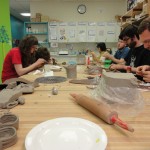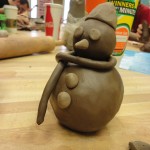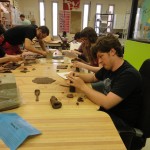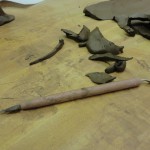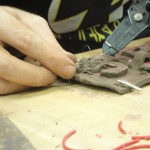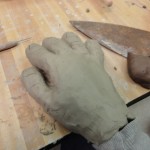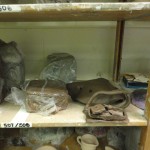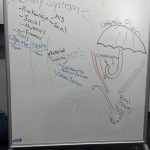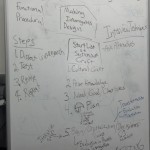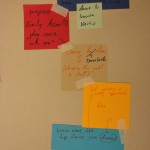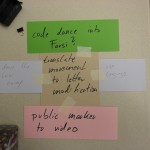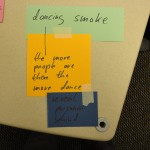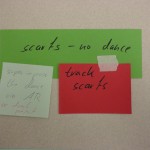Author Archive
Wednesday, September 16th, 2015
Some impressions of the work seen at the Cherrylion studio:
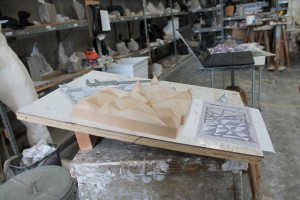 A foam-based model for a later project – all inspired by a 2D goes 3D idea. Clay for Marty is more a tool, a stepping stone toward the casting (often done in metal or whatever material, really). See below for one of those strange forms – this one used a pizza cutter to create the edgy look.
A foam-based model for a later project – all inspired by a 2D goes 3D idea. Clay for Marty is more a tool, a stepping stone toward the casting (often done in metal or whatever material, really). See below for one of those strange forms – this one used a pizza cutter to create the edgy look.
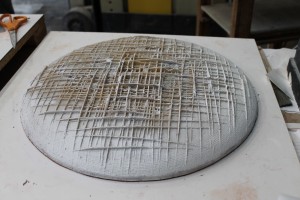
The place itself:
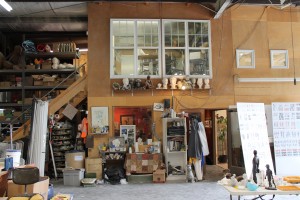

Posted in Uncategorized | No Comments »
Monday, September 14th, 2015
To give some idea about Rachel’s work – some of it we discussed last week – here is the great nut project:

And you can find more info on her work here.
Posted in clay | No Comments »
Monday, February 18th, 2013
Posted in Uncategorized | No Comments »
Tuesday, February 12th, 2013
There are some presentations over here at TEI 2013 that kind of touch on craft. One is Movement Crafter
The movement crafter attempts to reconcile the pace of new technologies with traditional crafting activities that are performed as pastimes. The project explores concepts of quiet communication and technology hybrids and attempts to support crafting without making the craftsperson overly selfconscious of their practice.
What it does is tracking the movements of two pairs of knitting needles and visualizing it. When I tried it only one of the two stations worked and it was not too precise. But it kind of relates to the handiwork concept from Ashton.
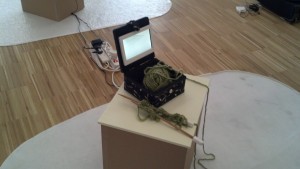
Another art project deals with the special ink that changes visibility under changing heat.
Transience is the Japanese calligraphy work with dynamic color changes. The scene where the letter colors are changing from moment to moment can give af”uent dynamism and feeling of vitality of calligraphy to viewers, and at the same time, it can express stream of time. Calligraphy is integrated with technology and materials seamlessly and Transience is produced to show ever-changing aesthetics fermented in Japan. In order to change letter colors on paper, we developed our original chromogenic mechanism from functional inks and conductive materials. For producing the chromogenic technology suitable for paper, we examined ink materials repeatedly, and as a result we realized the expression where calligraphy harmonizes with computer.
It was beautiful to see the change of the ink over time – but mainly because the lettering looked so good. Paint Pulse was definitely more ambitious.

Posted in Uncategorized | No Comments »
Wednesday, February 6th, 2013
Our scribbles from the discussion today regarding guides and rules for digital intervention in craft.

Posted in Uncategorized | No Comments »
Wednesday, February 6th, 2013
Sam pointed me to that – and some of us might not be aware of this trend:
Open Source Philosophy. from Open Source Ecology on Vimeo.
Their spearhead project is the Global Village Construction Kit. As we drift into crafting and social context, it might be a good touching point for where digital media stand.
Posted in Uncategorized | No Comments »
Monday, February 4th, 2013
Today we finally played with some pottery at the craft center. And DWIG became the proud owner of its own storage shelf.
Posted in Uncategorized | No Comments »
Thursday, January 31st, 2013
Now that you have documented a practice as a logical action and planning breakdown we turn to the experiential parts of it. Look at the breakdown of the practice, identify a key moment that exemplifies the “feel” for this practice. It should answer the question of what is the most experience-based (including sensual, illogical, personal, joyful, painful) part of this practice? Design something that recreates the experiential quality of this moment.
It does not have to use the practice (e.g. if you want to describe the feeling of wood fibers you might do that with woolen threads) but should reflect the chosen key moment.
Posted in Uncategorized | No Comments »
Monday, January 28th, 2013
Here is the Instructable for last term’s Sand Tones project – now aptly titled Craft Cymatics.
Posted in Uncategorized | No Comments »
Thursday, January 24th, 2013
Below our scribbles from the Keller and Keller text – to guide your practice analysis for next week:
Posted in Uncategorized | No Comments »
Wednesday, January 23rd, 2013
Based on our breakdown of the Keller & Keller text.
Find one practice you feel comfortable with and analyze it using Keller&Keller. What are the actions? What is the actions’ “emergent quality” that evolves from the activity system you are looking at? What knowledge is applied and altered in the process? At what stage is an “umbrella plan” defined? On what grounds is that plan made? What are the ingredients of that plan?
I would suggest to use the outline and key words we discussed in class to guide your analysis. This is meant to let us develop the method which we will apply to our analysis of an existing craft practice in the foreseeable future. So if you find a problem in the Keller & Keller approach and can provide an improvement – by all means.
Posted in Uncategorized | No Comments »
Wednesday, January 16th, 2013
Design challenge: This assignment builds on a combination of Dormer, Risatti, and McCullough. McCullough particularly calls for a “defense of skill” and Dormer (and others) discuss the difference between assembly and craft in a comparable way. Between following rules, which could be done by a machine, vs creative making, which depends on the personal investment and skill.
Your design challenge is in-between these poles: present a kit of prepared items and simple to follow rules toward a specific object, but (re)design this kit in such a way that one specific skill is not replaced by the materials and manuals at hand. Include a digital component in that kit.
Posted in Uncategorized | No Comments »
Wednesday, September 19th, 2012
Find an example of a ecological system – what we are preliminarily call a “communal space.” Identify the actors and notable conditions in it. Create some form of visualization of it (to communicate your idea) – then design at least three performative interventions in it that use some form of digital media. Elaborate one of these cases and present that as your case study. Avoid to produce a “flavor of hell” as Laurel calls it.
Posted in Uncategorized | No Comments »
Friday, September 14th, 2012
Looking at Gaver and our very own Rock all the Things project: they propagate play as expressive form with digital media. The new challenge copies this approach and consists of two steps: 1) find a skill/ play property that most of us share 2) exploit this in a way that this activity becomes productive. Do so using digital stuff.
Posted in Uncategorized | No Comments »
Friday, September 7th, 2012
Combining the user vs designer discussion and the risk vs certainty discussion:
Take an existing digital device (phone, GPS system, laptop, whatever) and re-imagine it in a way where user and design “time” get closer together. You goal is to get “users” to (re)design the object. Your challenge is to provide means for this re-design.
Posted in Uncategorized | No Comments »
Tuesday, September 4th, 2012
Welcome back!
The first design challenge for the new term follows Ratto’s ideas of critical making: Design a “messing about” one that aims to fulfill Greer’s point: “A space for conversation opens up somehow, with this simple act.” Looking forward to see the ideas.
Posted in Uncategorized | No Comments »
Wednesday, June 27th, 2012
Some news clip on the Invention Lab and the Maker Club at Tech.

Should be worth a look once the term is back on track.
Posted in Uncategorized | No Comments »
Wednesday, April 11th, 2012
Via incoming PhD candidate Mariam Asad: awesome biomedia project

Posted in unrelated bits | No Comments »
Tuesday, January 31st, 2012
As mentioned in class: our main challenge this term will be organized a bit differently this year. Instead of ever-new small design challenges we will have one continuous one until the end of February. At that time, we will select one or two of our projects, optimize, and implement them.
Underlying is the main approach for this term: the idea of interaction as performance and both as being process-based. Crafts and making cultures are seen as equally process-based. Thus, we aim to design a digital craft process – the making of something as the “big challenge.”
We want to spend a bit more time on the process of developing our ideas. So the first deliverable (next week) will be a presentation of the idea – just like our concept presentations last term. The second step is presentation of a prototype (the week later). If possible, it would be good to test your process already on the rest of the group like we did with our projects this week. Finally, we will have 5 different and revised projects that we, then, optimize for a submission to Flux projects.
You can find out more about Flux here.
But please remember the experiment we are doing here focuses on the question what parallels we can detect between the making and the interacting and the performing processes.
Posted in Uncategorized | No Comments »
Sunday, January 29th, 2012
This idea was inspired by the ornamental work that was part of the William Morris article we read for the week – and how his sense of form and function differs from the cooperate style that is so dominant at Georgia Tech. I am often confused by ornamental art and wonder why anybody would spend his or her time making exactly this pattern. Here is one of Morris’ patterns, for example:
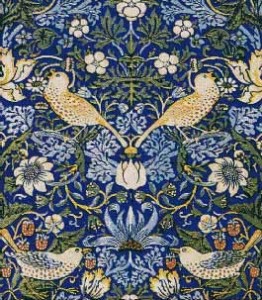
So, in my project I try to get a pattern without really designing it but instead using pure functionality. To do so, the project uses print techniques and computer hardware components as shapes.
The main design task for a motherboard or circuit is functionality. To save space and money, these boards are usually optimized not for any aesthetic value but for cheapest and most reliable operation. What if one could take the trace of this optimization and use it in our crafts context? Then you would get a shape that reflects optimized function but – I argue in this project – is also an ornamental pattern.
To do my craft exercise, you need:
– colors
– brushes
– an old board (I took one from an old remote control car)
– some paper
– some piece of clothing (I used some socks)
You paint the backside of the board with a color of your choice, do some test prints on the paper to get rid of the surplus paint, and when you start to get the desired result with the motherboard shape, you print on the piece of clothing.
I used a remote control car and some socks to play with the idea that you can wear the interiors of a electric car on your feet. Maybe it speeds you up?
Posted in Uncategorized | 1 Comment »
Wednesday, January 18th, 2012
Welcome to the new year – and the new challenge.
As we turn our attention to crafts and digital media a key question is how to incorporate these crafts. One approach is to focus on the procedurality of crafts. One has to “make.” The challenge for this week is in this spirit:
Create a “craft activity” that is a gift for somebody else. The person, for whom the activity is, should engage with your piece and this engagement, the “making” is where we see currently the craft included. It would be fabulous to include digital media, but if your “craft activity” is analogue only, that is okay, too.
Posted in Uncategorized | No Comments »
Thursday, November 3rd, 2011
deliverable:
1) Kinect sensor
recognize motion activity in a certain square
– can we adjust the level of detection per square?
– how many kids?
– do we get constant garble from the lowest row?
– how to deal with the height/ width of the final performance area
question: do we need some visual feedback for which square you trigger?
FK: Nov 16
video format? can we make sure we get certain data limitations?
are kids making own content or collection from the web?
should we give them a cheat sheet to do the movies the way we want them?
2) Media playback
– when you get a message you play a data (any kind: sound, video, graphics) that you pull from a folder
– we fade out after 10 sec OR when the media is done
– we want dynamic mapping
– idea: can we play all media all the time and just change visibility?
XACN: Nov 16
give us a tech spec for the data
3) combined piece
DUE Nov 30
Posted in Uncategorized | No Comments »
Wednesday, October 12th, 2011
The technical part of this challenge is: create something that allows us to scan/ register an existing space. This virtual form of the space, then, is a sort of collection space where the students can assemble, activate, perform … things related to the site or to historical elements of the civil right movement.
We cannot provide for all kinds of data collections – so part of the design challenge is to limit the students’ access in a reasonable but still engaging way.
With this challenge we move ever closer to the final project to be implemented, so keep the feasibility of your idea in mind. In fact, include a breakdown of who does what from the group in your presentation.
Posted in Uncategorized | No Comments »
Thursday, October 6th, 2011
See below the scribbled notes taken during the session 10/5
Posted in Uncategorized | No Comments »
Wednesday, September 28th, 2011
This is our second external challenge and while we are not committed to implement it, I would encourage us to think in a “could do this” way. Just to keep the options open.
Let’s break this one down a bit:
This challenge is about the translation of gesture into some other form. Such a “translation” happens on the media level (e.g. into sound, text, sculpture etc.) as well as the cultural level (as it enters new settings and conditions).
The particular cultural condition for us is: an Iranian woman is not allowed to dance in her homeland. Her dances in public spaces in NYC are dealing with this, but cannot really answer the underlying cause, because of the forced distance and the fact that she cannot get back. Thus, the task is to find a way to translate movements (and we should think beyond the dance we saw) into another form – ship this form to Teheran – and install it at a public space there.
This would be a one-way directed performance – and the first and primary target. However, the bonus round is to think about how local Iranian artists could react and collaborate with this dance on the basis of our transformation.
Another element to keep in mind are the conditions in Iran, the danger of any public performance and the security of anybody involved in such a piece (whether it is this subway or the plaza).
To add some notes from Michael: there are a number of massive challenges that hover under the surface of this challenge: e.g. transformation of time and place and context – all this in a cultural context we cannot fully grasp. Let’s focus on the particular set up with our client and not let’s not get overburdened by the big shift between these two worlds.
Second note: as we will have to communicate this back via Skype: be as visual and tactile and cinematic and dramatic and expressive … as possible in your concept presentation next week.
Posted in Uncategorized | No Comments »
Wednesday, September 21st, 2011
this time we will try to include the process into the design challenge and we would like to proceed with a view toward the Dourish paper. In some ways the challenge is a practice-based response to the paper.
step one: find a context
step two: analyze it in what Dourish called “positivist” way
step three: break it down to a “phenomenological” counter approach
from these analyses evolves your particular problem
step four: based on step three > suggest a digital thing
We would love to see your process when you do your print out/ presentation.
Posted in Uncategorized | No Comments »
Thursday, September 15th, 2011
From Friedrich:
In case any of you are interested in Open Hardware, they are streaming the whole thing live from New York:

Posted in Uncategorized | No Comments »
Wednesday, September 14th, 2011
design challenge for September 14th
This challenge is based on the quote used in Potteiger/ Purinton “To exist historically is to perceive the events one lives through as part of a story later to be told” (see p 4); create a digital media “thing” that puts a 14-year old into such a frame. The history field we are talking about is the civil rights movement.
As an extra incentive: keep in mind the evolution from exploration/ discovery of something to a state of transformation/ creation to a state of replanting/ distributing. History, here, should not be seen as a thing of a distant past but in relation to one’s life in the here and now.
Posted in Uncategorized | No Comments »
Friday, September 2nd, 2011
Here is our initial “warm up” design challenge on the official channel:
the jump off points for the design challenge from the readings was a combination of the
“frame” as described by Bateson
and the “wittingness” as described by Sheridan
and the role of theater as described by Boal (we talked less about that, so here is the key quote, I want to stress: “The theatrical language is the most essential human language. Everything that actors do on stage, we do throughout our lives, always and everywhere. Actors talk, move, dress to suit the setting, express ideas, reveal passions -just as we all do in our daily lives The only difference is that actors are conscious that they are using the language of theatre, and are thus better able to tum it to their advantage, whereas the woman and man in the street do not know that they are speaking theatre”)
The assignment is:
Find an everyday movement that happens in daily life.
Design an intervention that changes our awareness (wittingness, if you want) and transforms us to actors (spect-actors, if you want).
The goal of that intervention is a change in behavior for this movement.
Your intervention should be non-digital as we will be digital enough in the future.
Due in two weeks – so I hope to see some working designs.
Posted in Uncategorized | 2 Comments »
Thursday, July 28th, 2011

In case anybody is traveling to the big city, this one might be worth a look:
MoMA EXHIBITION INVESTIGATES THE COMMUNICATION BETWEEN PEOPLE AND OBJECTS THROUGH DESIGN
Installation Provides Visitors with Greater Access to Information by Incorporating the Use of Technology, Including QR Codes and Twitter Hashtags for Each Object
Talk to Me: Design and the Communication between People and Objects
July 24–November 7, 2011
Special Exhibitions Gallery, third floor
Their website has videos of all the demos online. As I the question on “what makes a good demo video?” is still open, maybe there is some inspiration there.
Posted in Uncategorized | No Comments »
 A foam-based model for a later project – all inspired by a 2D goes 3D idea. Clay for Marty is more a tool, a stepping stone toward the casting (often done in metal or whatever material, really). See below for one of those strange forms – this one used a pizza cutter to create the edgy look.
A foam-based model for a later project – all inspired by a 2D goes 3D idea. Clay for Marty is more a tool, a stepping stone toward the casting (often done in metal or whatever material, really). See below for one of those strange forms – this one used a pizza cutter to create the edgy look.







